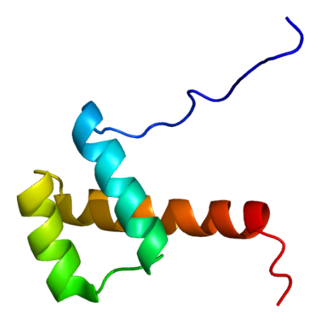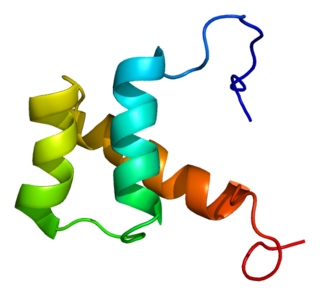Homeobox protein engrailed-1 is a protein that in humans is encoded by the EN1 gene. [5] [6]
Homeobox protein engrailed-1 is a protein that in humans is encoded by the EN1 gene. [5] [6]
Homeobox-containing genes are thought to have a role in controlling development. In Drosophila , the engrailed (en) gene plays an important role during development in segmentation, where it is required for the formation of posterior compartments. Different mutations in the mouse homologs, En1 and En2, produced different developmental defects that frequently are lethal. The human engrailed homologs 1 and 2 encode homeodomain-containing proteins and have been implicated in the control of pattern formation during development of the central nervous system and the limbs. [6]
Engrailed (En) 1 is a homeobox gene that helps regulate development in the dorsal midbrain and anterior hindbrain (cerebellum and colliculi) of humans. It is also essential in regulating the establishment of a dorso-ventral pattern in developing limbs. The expression of En1 is regulated until 13 days after fertilization by Fgf8, which controls the development of the forebrain and hindbrain. En1 is first expressed in this region on day 9.5 after fertilization for about 12 hours until En2 is expressed. After En2 expression, En1 is expressed again in other tissues such as somites and limb ectoderm throughout development. [7] A knockout mouse model with the En1 homeobox deleted was developed; mice died less than 24 hours after birth because appeared to be unable to feed. The brains of the mice were studied and most of the cerebellum, colliculi, and cranial nerves 3 and 4 were missing. There was clear deletion in the mid-hindbrain, isthmus, junction region that began at day 9.5 after fertilization. All of the mice demonstrated marked forepaw deformities including fusion of digits and abnormal dorso-ventral patterning. The 13th ribs and sternums displayed delayed and abnormal ossification. The mouse model demonstrated that the expression of En1 is critical in the correct development of the brain, limbs, and sternum. [8]
In 2021, a group of scientists and physicians around Andrea Superti-Furga in Lausanne and Stefan Mundlos in Berlin showed that biallelic loss-of-function variants at the EN1 locus result in a human phenotype that includes a severe impairment of limb development as well as cerebellar aplasia, [9] reproducing the phenotype first observed in the gene knock-out mice described above. They also found that there is a long non-coding RNA (lncRNA) element at approx. 300 kb distance from EN1, that they called MAENLI (for Master on Engrailed-1 in the Limbs), that is responsible for activation of EN1 gene expression in the developing limbs. The biallelic loss of the MAENLI lncRNA element results in impairment of limb development in humans as seen in the EN1-associated condition, while cerebellar development is not affected.

Pre-B-cell leukemia transcription factor 1 is a protein that in humans is encoded by the PBX1 gene. The homologous protein in Drosophila is known as extradenticle, and causes changes in embryonic development.

Paired-like homeodomain transcription factor 2 also known as pituitary homeobox 2 is a protein that in humans is encoded by the PITX2 gene.

Homeobox protein Hox-A1 is a protein that in humans is encoded by the HOXA1 gene.

Homeobox D10, also known as HOXD10, is a protein which in humans is encoded by the HOXD10 gene.

Hematopoietically-expressed homeobox protein HHEX is a protein that in humans is encoded by the HHEX gene and also known as Proline Rich Homeodomain protein PRH.

Homeobox protein engrailed-2 is a protein that in humans is encoded by the EN2 gene. It is a member of the engrailed gene family.

PBX/Knotted 1 Homeobox 1 (PKNOX1) is a protein that in humans is encoded by the PKNOX1 gene.

Homeobox protein DLX-4 is a protein that in humans is encoded by the DLX4 gene.

Paired-like homeodomain 1 is a protein that in humans is encoded by the PITX1 gene.

Homeobox protein OTX2 is a protein that in humans is encoded by the OTX2 gene.

Homeobox protein Hox-D11 is a protein that in humans is encoded by the HOXD11 gene.

Paired related homeobox 1 is a protein that in humans is encoded by the PRRX1 gene.

Homeobox protein DLX-2 is a protein that in humans is encoded by the DLX2 gene.

Homeobox protein Meis2 is a protein that in humans is encoded by the MEIS2 gene.

Homeobox protein Nkx-2.3 is a protein that in humans is encoded by the NKX2-3 gene.

LIM/homeobox protein Lhx4 is a protein that in humans is encoded by the LHX4 gene.

Homeobox protein GBX-2 is a protein that in humans is encoded by the GBX2 gene.

Homeobox protein Hox-A2 is a protein that in humans is encoded by the HOXA2 gene.

Iroquois-class homeodomain protein IRX-1, also known as Iroquois homeobox protein 1, is a protein that in humans is encoded by the IRX1 gene. All members of the Iroquois (IRO) family of proteins share two highly conserved features, encoding both a homeodomain and a characteristic IRO sequence motif. Members of this family are known to play numerous roles in early embryo patterning. IRX1 has also been shown to act as a tumor suppressor gene in several forms of cancer.

Homeobox protein NOBOX, also known as newborn ovary homeobox protein, is a protein that in humans is encoded by the NOBOX gene. The official symbol (NOBOX) and the official full name are maintained by the HGNC. The NOBOX gene is conserved in chimpanzee, Rhesus monkey, cow, mouse, and rat. There are 175 organisms that have orthologs with human gene NOBOX. It is capable of regulating other genes that are important in the development of follicles. Follicles do not develop and oocytes decrease in its absence which lead to infertility.
This article incorporates text from the United States National Library of Medicine, which is in the public domain.